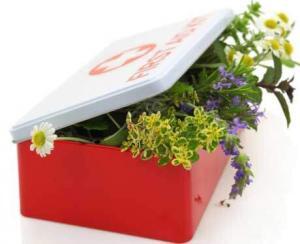
Herbal medicine is the oldest and still most widely used system of healing in the world today. Preparations, made exclusively from plants (seeds, roots, stems, flowers, leaves), may be put into many forms – tinctures, extracts, teas, salves, etc. When used appropriately, these remedies can be highly effective, relatively inexpensive and minus the toxic side effects of synthetic pharmaceutical meds. Here are some suggestions for your home herbal first aid kit:
- Cuts and scrapes. Use an antimicrobial healing salve. Many health food stores are now carrying comfrey cream for sprains, cuts, bruises, scrapes and all kinds of minor (or not so minor) trauma. Comfrey contains potent anti-bacterial, antiseptic and anti-inflammatory compounds that ease pain and hasten healing. Just make sure the cream contains “trauma comfrey” – a special cultivar free of toxic compounds known as PAs which are toxic to the liver. An excellent brand is “Comfrey Cream” by Traumaplant, Symphytum x uplandicum NYMAN, developed in Germany.
- Blisters. Tea tree oil has strong anti-microbial and antiseptic properties. Never pop a blister; that just invites infection. If one pops on its own, wash the area with soap and water and dab with tea tree oil. Cover with a gauze bandage; change the dressing daily.
- Burns. For any type, sun or hot iron, etc., take immediate action. First, cool the burn by immersing in cold water – cold numbs the pain, prevents injury. Then apply a wet tea bag (regular black tea) – the tannic acid and theobromine help remove heat from a sunburn. Also, catechins in tea help repair sun-damaged skin. Finish off by applying pain-relieving trauma comfrey cream.
- Nausea and indigestion. There are many herbal blends available as tinctures or teas or you can just chew the seeds. Look for bail, caraway, coriander, cumin, fennel, cardamom, lemon, ginger, peppermint. These herbs also reduce flatulence, bloating, decrease cramping, improve bile flow.
- Splinters. Slivers of wood, metal or glass should be removed as soon as possible to avoid infection. Soak in hot water for a few minutes, then use sterilized tweezers or a sewing needle to work the splinter out. Wash with soap and water to disinfect before applying trauma comfrey cream.
- Muscles aches and pains. For external use, arnica oil, along with witch hazel, St. John’s wort and essential oils of camphor, eucalyptus, rosemary and clove are excellent. Massage well and frequently, but do not use on broken skin.
- Headache. Willow bark in tea or capsule form has the analgesic properties of commercial aspirin. In fact, it was the model for factory-made aspirin. It is milder, but gentler on the stomach. Also, massaging the head area with peppermint essential oil in a carrier oil (like coconut, almond, etc.) can be very relieving.
- Calm, sleep promotion. Drink some tea made with chamomile, passion flower, valerian, or lavender or put drops from a tincture of one of these herbs in a little water. Before bed, massage a little lavender essential oil on the chest.
- Cold, flu or bronchitis. Thyme essential oil has many properties, including antispasmodic, antirheumatic, antiseptic, bactericidal, expectorant, etc. Boil some water in a pot. Turn off heat and put in several drops of thyme essential oil. Inhale the steam.
- Bug bite and itch relief. Generously apply witch hazel. Lavender oil can be added to enhance the effect.
Sources:
East West School of Planetary Herbology
Green Path Herb School
Earth Mama




